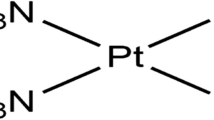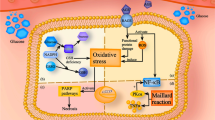Abstract
Objective
To explore the mechanism of the protective effects of Panax notoginseng saponins (PNS) on kidney in diabetic rats.
Methods
Diabetic rat model was obtained by intravenous injection of alloxan, and the rats were divided into model, PNS-100 mg/(kg day) and PNS-200 mg/(kg day) groups, 10 each. Another 10 rats injected with saline were served as control. Periodic acid-Schiff staining and immunological histological chemistry were used to observe histomorphology and tissue expression of bone morphogenetic protein-7 (BMP-7). Silent information regulator 1 (SIRT1) was silenced in rat mesangial cells by RNA interference. The mRNA expressions of SIRT-1, monocyte chemoattractant protein-1 (MCP-1), transforming growth factor β1 (TGF-β1) and plasminogen activator inhibitor-1 (PAI-1) were analyzed by reverse transcription polymerase chain reaction. The protein expressions of SIRT1 and the acetylation of nuclear factor κB (NF-κB) P65 were determined by western blotting. The concentration of MCP-1, TGF-β1 and malondialdehyde (MDA) in culture supernatant were detected by enzyme-linked immuno sorbent assay. The activity of superoxide dismutase (SOD) was detected by the classical method of nitrogen and blue four.
Results
In diabetic model rats, PNS could not only reduce blood glucose and lipid (P<0.01), but also increase protein level of BMP-7 and inhibit PAI-1 expression for suppressing fibrosis of the kidney. In rat mesangial cells, PNS could up-regulate the expression of SIRT1 (P<0.01) and in turn suppress the transcription of TGF-β1 (P<0.05) and MCP-1 (P<0.05). PNS could also reverse the increased acetylation of NF-κB p65 by high glucose. In addition, redox regulation factor MDA was down-regulated (P<0.05) and SOD was up-regulated (P<0.01), which were both induced by SIRT1 up-regulation.
Conclusions
PNS could protect kidney from diabetes with the possible mechanism of up-regulating SIRT1, therefore inhibiting inflammation through decreasing the induction of inflammatory cytokines and TGF-β1, as well as activating antioxidant proteins.
Similar content being viewed by others
References
Shang Q, Xu H, Liu Z, Chen K, Liu J. Oral Panax notoginseng preparation for coronary heart disease: a systematic review of randomized controlled trials. Evid Based Complement Alternat Med 2013;2013:940125.
Zhang Y, Han LF, Sakah KJ, Wu ZZ, Liu LL, Agyemang K, et al. Bioactive protopanaxatriol type saponins isolated from the roots of Panax notoginseng (Burk.) F. H. Chen. Molecules 2013;18:10352–10366.
Ng TB. Pharmacological activity of Sanchi ginseng (Panax notoginseng). J Pharm Pharmacol 2006;58:1007–1019.
Uzayisenga R, Ayeka PA, Wang Y, Anti-diabetic potential of Panax notoginseng saponins (PNS): a review. Phytother Res 2014;28:510–516.
Tavafi M. Diabetic nephropathy and antioxidants. J Nephropathol 2013;2:20–27.
Gosmanov AR, Wall BM, Gosmanova EO. Diagnosis and treatment of diabetic kidney disease. Am J Med Sci 2014;347:406–413.
Tu Q, Qin J, Dong H, Lu F, Guan W. Effects of Panax notoginoside on the expression of TGF-beta1 and Smad-7 in renal tissues of diabetic rats. J Huazhong Univ Sci Technol Med Sci (Chin) 2011;31:190–193.
Lang J, Cao H, Wei A. Comparative study on effect of Panax notoginseng and ticlid in treating early diabetic nephropathy. Chin J Integr Tradit West Med (Chin) 1998;18:727–729.
Garud MS, Kulkarni YA. Hyperglycemia to nephropathy via transforming growth factor beta. Curr Diabetes Rev 2014;10:182–189.
Ahad A, Ganai AA, Mujeeb M, Siddiqui WA. Ellagic acid, an NF-kappaB inhibitor, ameliorates renal function in experimental diabetic nephropathy. Chem Biol Interact 2014;219:64–75.
Lan HY. Transforming growth factor-beta/Smad signalling in diabetic nephropathy. Clin Exp Pharmacol Physiol 2012;39:731–738.
Nakamura T, Miller D, Ruoslahti E, Border WA. Production of extracellular matrix by glomerular epithelial cells is regulated by transforming growth factor-beta 1. Kidney Int 1992;41:1213–1221.
Miner JH. Renal basement membrane components. Kidney Int 1999;56:2016–2024.
Patek CE, Fleming S, Miles CG, Bellamy CO, Ladomery M, Spraggon L, et al. Murine denys-drash syndrome: evidence of podocyte de-differentiation and systemic mediation of glomerulosclerosis. Hum Mol Genet 2003;12:2379–2394.
Lee HS. Pathogenic role of TGF-beta in the progression of podocyte diseases. Histol Histopathol 2011;26:107–116.
Mitu G, Hirschberg R. Bone morphogenetic protein-7 (BMP7) in chronic kidney disease. Front Biosci 2008;13:4726–4739.
Meng XM, Chung AC, Lan HY. Role of the TGF-beta/BMP-7/Smad pathways in renal diseases. Clin Sci (Lond) 2013;124:243–254.
Malgorzewicz S, Skrzypczak-Jankun E, Jankun J. Plasminogen activator inhibitor-1 in kidney pathology (review). Int J Mol Med 2013;31:503–510.
Li T, Surendran K, Zawaideh MA, Mathew S, Hruska KA. Bone morphogenetic protein 7: a novel treatment for chronic renal and bone disease. Curr Opin Nephrol Hypertens 2004;13:417–422.
Wang P, Du B, Yin W, Wang X, Zhu W. Resveratrol attenuates CoCl2-induced cochlear hair cell damage through upregulation of Sirtuin1 and NF-kappaB deacetylation. PLoS One 2013;8:e80854.
Michan S, Juan AM, Hurst CG, Cui Z, Evans LP, Hatton CJ, et al. Sirtuin1 over-expression does not impact retinal vascular and neuronal degeneration in a mouse model of oxygen-induced retinopathy. PLoS One 2014;9:e85031.
Yang J, Zeng Z, Wu T, Yang Z, Liu B, Lan T. Emodin attenuates high glucose-induced TGF-beta1 and fibronectin expression in mesangial cells through inhibition of NFkappaB pathway. Exp Cell Res 2013;319:3182–3189.
Yi B, Hu X, Zhang H, Huang J, Liu J, Hu J, et al. Nuclear NF-kappaB p65 in peripheral blood mononuclear cells correlates with urinary mcp-1, rantes and the severity of type 2 diabetic nephropathy. PLoS One 2014;9:e99633.
Lan HY, Chung AC. TGF-beta/Smad signaling in kidney disease. Semin Nephrol 2012;32:236–243.
Zhang LN, Xie XS, Zuo C, Fan JM. Effect of ginsenoside Rgl on the expression of TNF-alpha and MCP-1 in rats with diabetic nephropathy. J Sichuan Univ (Med Sci ed, Chin) 2009;40:466–471.
Hou S, Zheng F, Li Y, Gao L, Zhang J. The protective effect of glycyrrhizic acid on renal tubular epithelial cell injury induced by high glucose. Int J Mol Sci 2014;15:15026–15043.
Kim JJ, Xiao H, Tan Y, Wang ZZ, Paul Seale J, Qu X. The effects and mechanism of saponins of Panax notogiseng on glucose metabolism in 3T3-L1 cells. Am J Chin Med 2009;37:1179–1189.
Rong L, Chen Y, He M, Zhou X. Panax notoginseng saponins attenuate acute lung injury induced by intestinal ischemia/reperfusion in rats. Respirology 2009;14:890–898.
Du YG, Chai KF, Wang LP. Effect of SIRT1 on high glucoseinduced NF-κB p65 subunit acetylation and MCP-1 expression in rat mesangial cells. Acad J Sec Mil Med Univ 2014;35(7):1–5.
Serdar M, Sertoglu E, Uyanik M, Tapan S, Akin K, Bilgi C, et al. Comparison of 8-hydroxy-2'-deoxyguanosine (8-OHdG) levels using mass spectrometer and urine albumin creatinine ratio as a predictor of development of diabetic nephropathy. Free Radic Res 2012;46:1291–1295.
Rodgers JT, Lerin C, Haas W, Gygi SP, Spiegelman BM, Puigserver P. Nutrient control of glucose homeostasis through a complex of PGC-1 alpha and SIRT1. Nature 2005;434:113–118.
Author information
Authors and Affiliations
Corresponding author
Additional information
Supported by National Natural Science Foundation of China (No. 81273615) and Zhejiang Provincial Natural Science Fund (No. Y2110849)
Rights and permissions
About this article
Cite this article
Du, Yg., Wang, Lp., Qian, Jw. et al. Panax notoginseng saponins protect kidney from diabetes by up-regulating silent information regulator 1 and activating antioxidant proteins in rats. Chin. J. Integr. Med. 22, 910–917 (2016). https://doi.org/10.1007/s11655-015-2446-1
Received:
Published:
Issue Date:
DOI: https://doi.org/10.1007/s11655-015-2446-1




